engine Lexus GS350 2007 Using the front audio system / LEXUS 2007 GS430/350 (OM30A04U) Service Manual
[x] Cancel search | Manufacturer: LEXUS, Model Year: 2007, Model line: GS350, Model: Lexus GS350 2007Pages: 562, PDF Size: 17.95 MB
Page 135 of 562

115
2-2. Instrument cluster
2
When driving
■System check display
After switching the engine switch to IG-ON mode, “CHECK” is displayed while
system operation is checked. When the system check is complete, “COMPLETED”
is displayed before returning to the normal screen.
CAUTION
■The multi-information display at low temperatures
Allow the interior of the vehicle to warm up before using the liquid crystal informa-
tion display. At extremely low temperatures, the information display monitor may
respond slowly, and display changes may be delayed.
Page 136 of 562
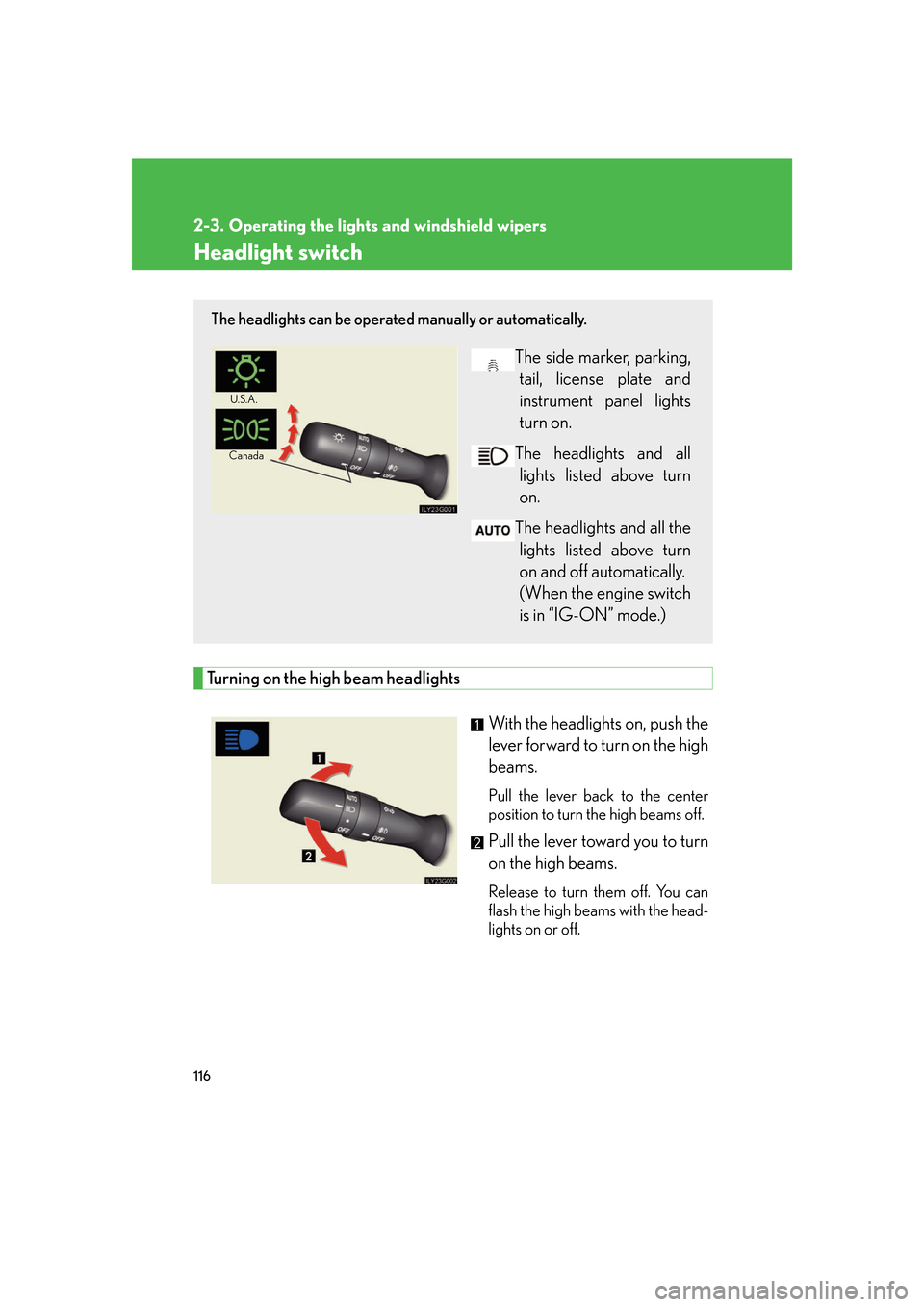
116
2-3. Operating the lights and windshield wipers
Headlight switch
Turning on the high beam headlights
With the headlights on, push the
lever forward to turn on the high
beams.
Pull the lever back to the center
position to turn the high beams off.
Pull the lever toward you to turn
on the high beams.
Release to turn them off. You can
flash the high beams with the head-
lights on or off.
The headlights can be operated manually or automatically.
The side marker, parking,
tail, license plate and
instrument panel lights
turn on.
The headlights and all lights listed above turn
on
.
The headlights and all the lights listed above turn
on and of
f automatically.
(When the engine switch
is in “IG-ON” mode.)
U.S.A.
Canada
Page 137 of 562
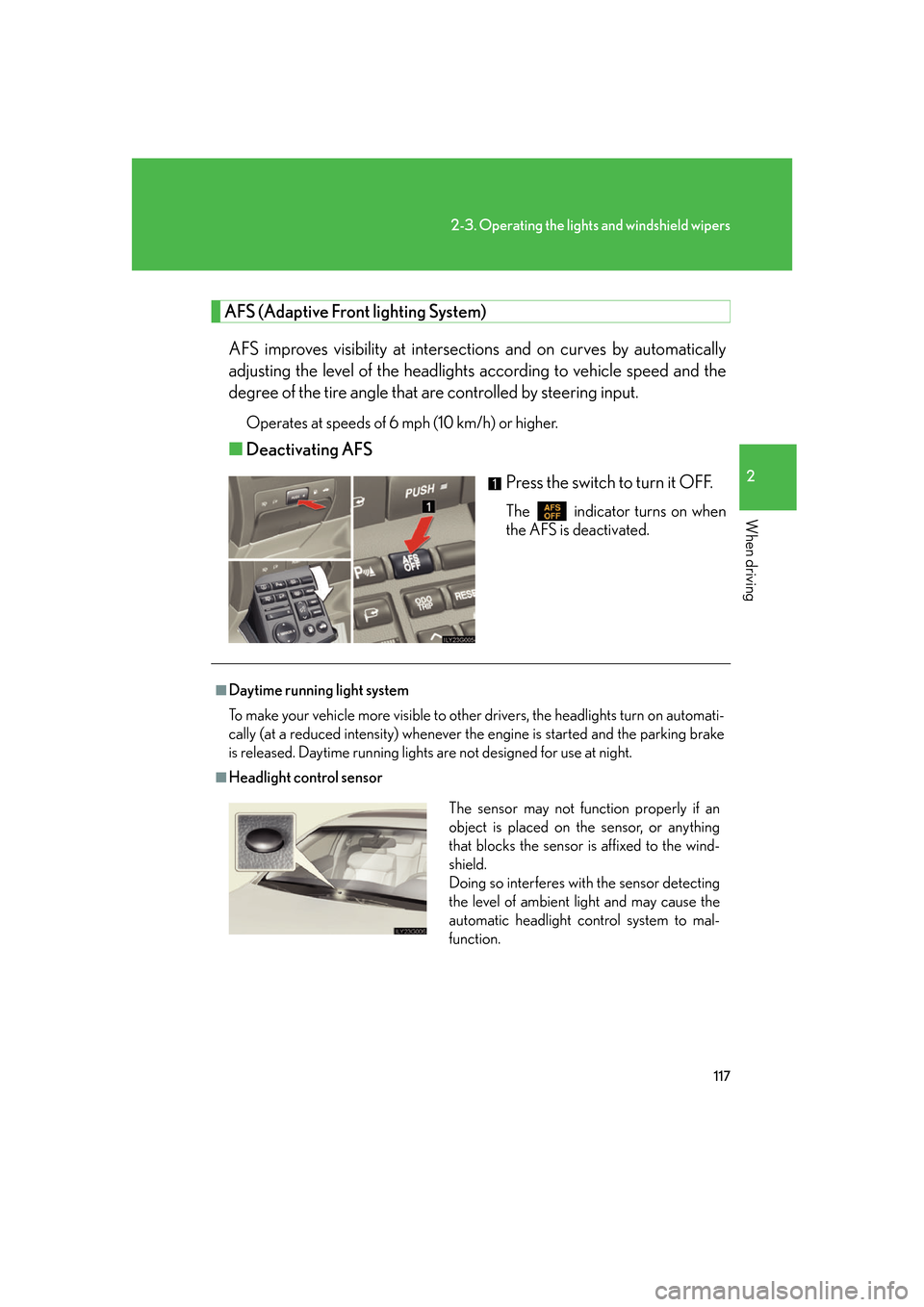
117
2-3. Operating the lights and windshield wipers
2
When driving
AFS (Adaptive Front lighting System)
AFS improves visibility at intersectio ns and on curves by automatically
adjusting the level of the headlights according to vehicle speed and the
degree of the tire angle that are controlled by steering input.
Operates at speeds of 6 mph (10 km/h) or higher.
■ Deactivating AFS
Press the switch to turn it OFF.
The indicator turns on when
the AFS is deactivated.
■Daytime running light system
To make your vehicle more visible to other drivers, the headlights turn on automati -
cally (at a reduced intensity) whenever the engine is started and the parking brake
is
released. Daytime running lights are not designed for use at night.
■Headlight control sensor
The sensor may not function properly if an
object is placed on the sensor, or anything
that blocks the sensor is affixed to the wind-
shield.
Doing so interferes with the sensor detecting
the level of ambient light and may cause the
automatic headlight control system to mal-
function.
Page 138 of 562
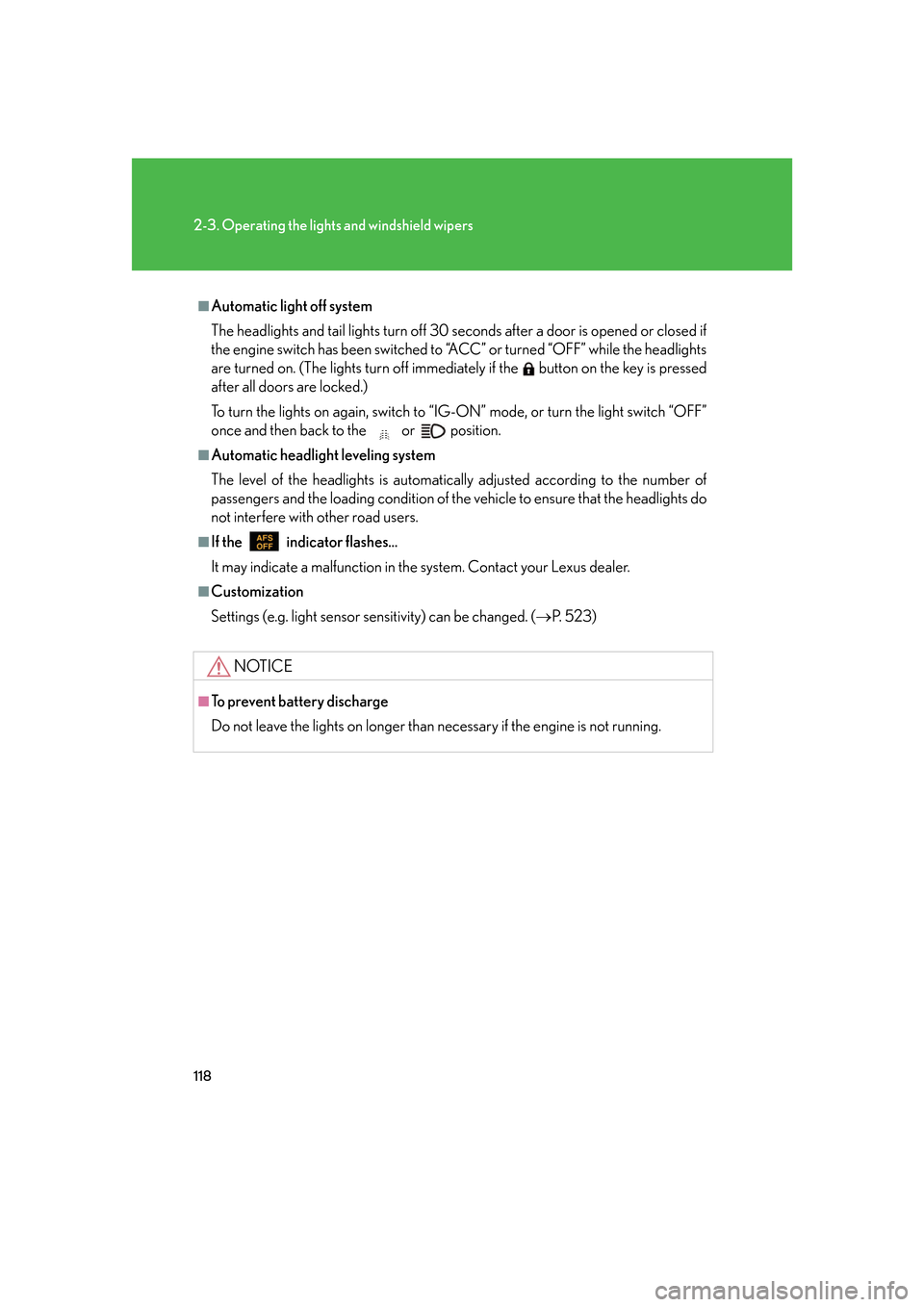
118
2-3. Operating the lights and windshield wipers
■Automatic light off system
The headlights and tail lights turn off 30 seconds after a door is opened or closed if
the engine switch has been switched to “ACC” or turned “OFF” while the headlights
are turned on. (The lights turn off immediately if the button on the key is pressed
after all doors are locked.)
To turn the lights on again, switch to “IG-ON” mode, or turn the light switch “OFF”
once and then back to the or position.
■Automatic headlight leveling system
The level of the headlights is automatica lly adjusted according to the number of
passengers and the loading condition of the vehicle to ensure that the headlights do
not interfere with other road users.
■If the indicator flashes...
It may indicate a malfunction in the system. Contact your Lexus dealer.
■Customization
Settings (e.g. light sensor sensitivity) can be changed. ( P. 5 2 3 )
NOTICE
■To prevent battery discharge
Do not leave the lights on longer than necessary if the engine is not running.
Page 141 of 562

121
2-3. Operating the lights and windshield wipers
2
When driving
■The windshield wiper and washer can be operated when
The engine switch is in “IG-ON” mode.
■Dripping prevention wiper sweep
After washing and wiping operation severa l
times, the wipers operate one more
time after a short delay to prevent dripping.
However, the last sweep will not happen if the vehicle is traveling above 106 mph
(1
70 km/h).
■Effects of vehicle speed on wiper operation
Vehicle speed affects the following even when the wipers are not in “AUTO” mode.
●Intermittent wiper interval (“INT” mode)
●Wiper operation when the washer is bein g used (delay until drip prevention
wiper sweep occurs)
With “LO” selected, wiper operation will be
switched from low speed to intermit-
tent wiper operation only when the vehicle is stationary.
■Rain drop sensor (vehicles equipped with the rain-sensing windshield wipers)
The sensor judges the amount of raindrops.
Page 143 of 562
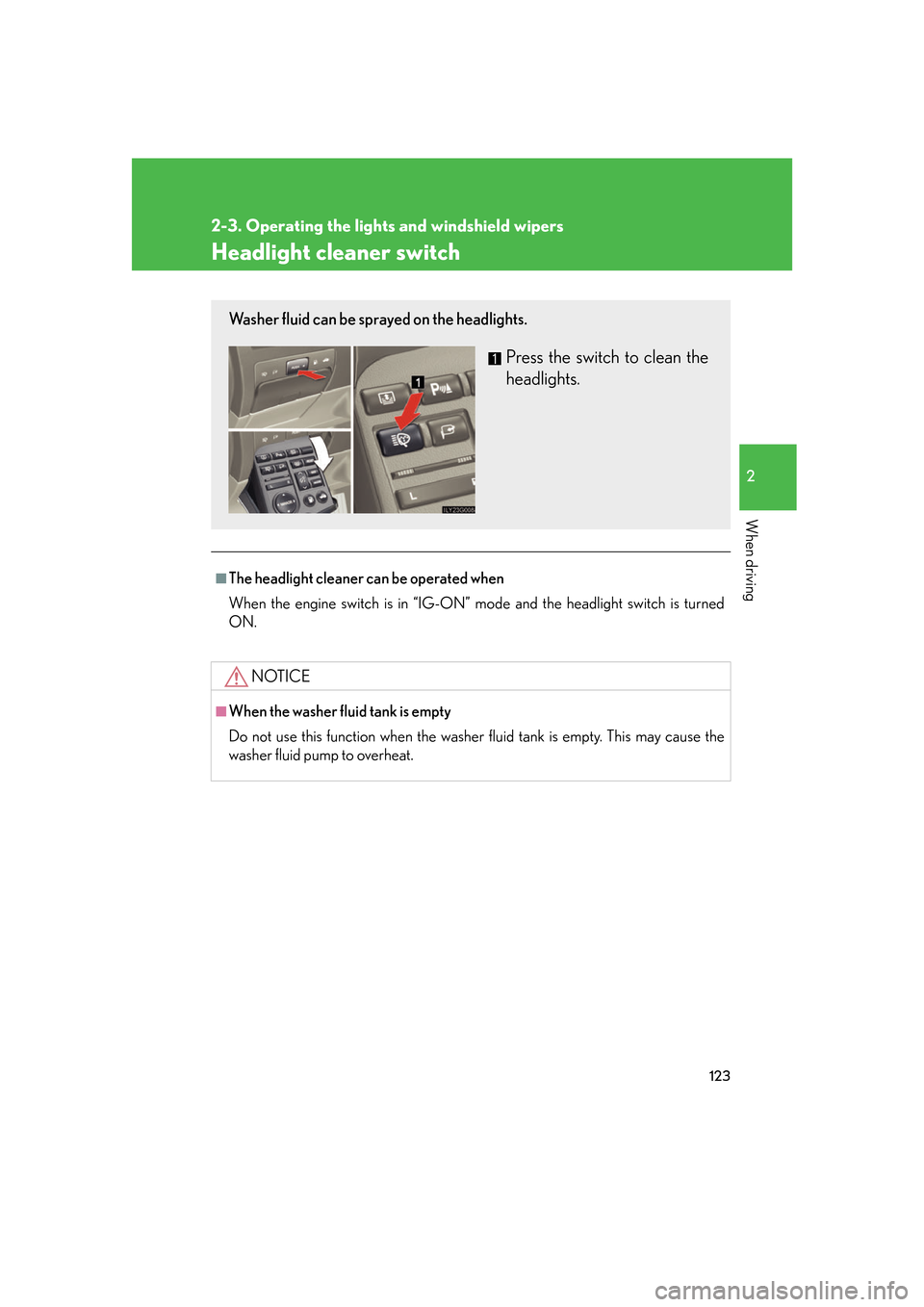
123
2-3. Operating the lights and windshield wipers
2
When driving
Headlight cleaner switch
■The headlight cleaner can be operated when
When the engine switch is in “IG-ON” mo de
and the headlight switch is turned
ON.
NOTICE
■When the washer fluid tank is empty
Do not use this function when the washer fluid tank is empty. This may cause the
washer fluid pump to overheat.
Washer fluid can be sprayed on the headlights.
Press the switch to clean the
headlights.
Page 147 of 562
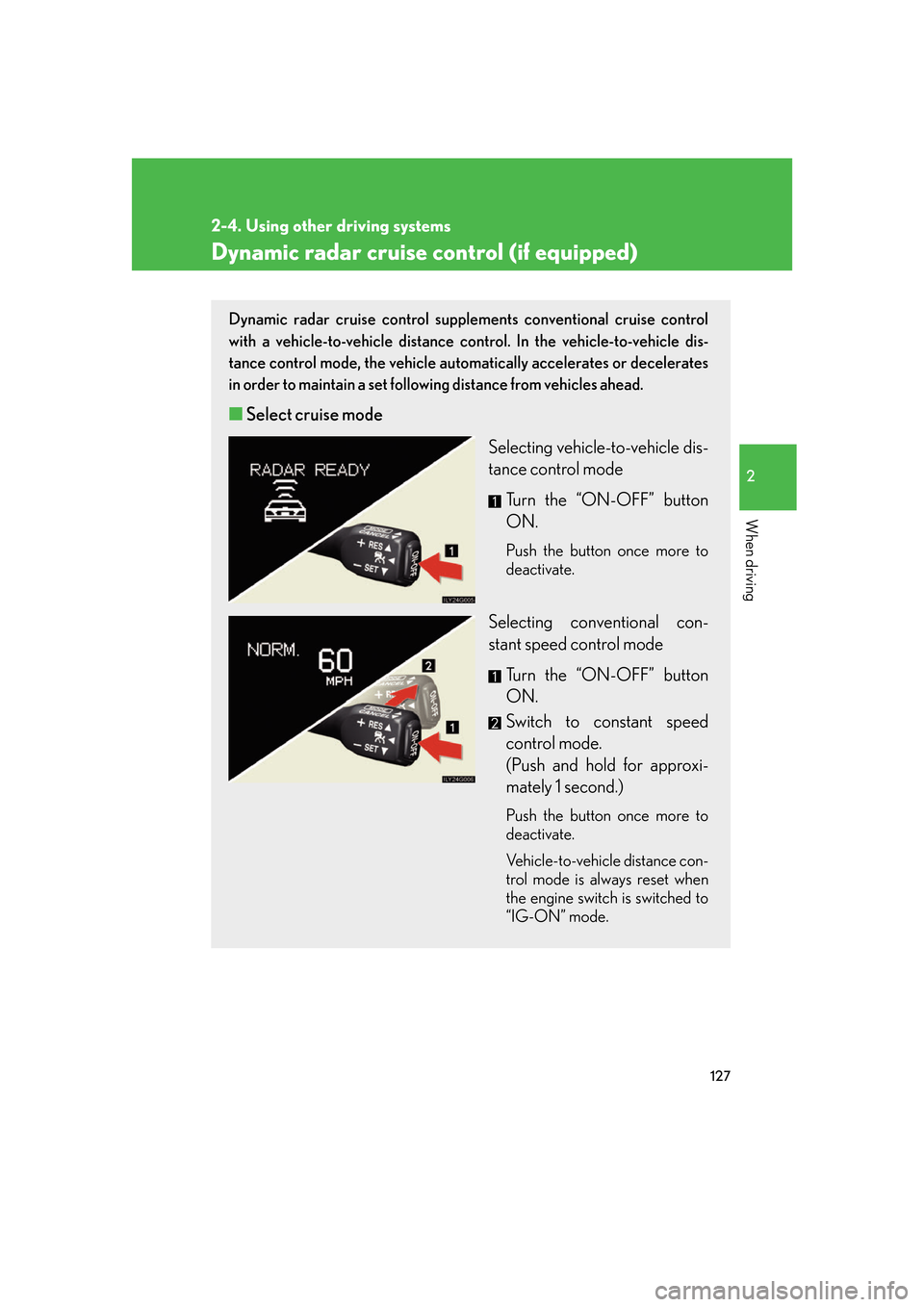
127
2-4. Using other driving systems
2
When driving
Dynamic radar cruise control (if equipped)
Dynamic radar cruise control supplements conventional cruise control
with a vehicle-to-vehicle distance control. In the vehicle-to-vehicle dis
-
tance control mode, the vehicle automa tic
ally accelerates or decelerates
in order to maintain a set following distance from vehicles ahead.
■ Select cruise mode
Selecting vehicle-to-vehicle dis-
tance control mode
Turn the “ON-OFF” button
ON.
Push the button once more to
deactivate.
Selecting conventional con -
stant speed control mode
Turn the “ON-OFF” button
ON.
Switch to constant speed
control mode.
(Push and hold for approxi -
mately 1 second.)
Push the button once more to
deactivate.
Vehicle-to-vehicle distance con -
trol mode is always reset when
the engine switch is switched
to
“IG-ON” mode.
Page 149 of 562

129
2-4. Using other driving systems
2
When driving
■Changing the vehicle-to-vehicle distance
Each pull of the switch changes
the vehicle-to-vehicle distance
Long
Medium
Short
The vehicle-to-vehicle distance
is automatically set to the long
mode when the engine switch is
set to the “IG-ON” mode.
A vehicle mark is displayed
ahead if one is detected.
Preceding
vehicle mark
Page 157 of 562

137
2-4. Using other driving systems
2
When driving
■Intuitive parking assist switch
Press the intuitive parking assist switch to turn the system on/off.
The indicator light will come
on when the intuitive parking
as
sist is turned ON.
You can use the system if the
engine switch is in the “IG-ON”
mode.
If intuitive parking assist is ON,
the s
ystem will operate under
the following conditions;
• The dual sensors will oper -
ate if the shift lever is in a
position
other than “R” or
“P”.
• All corner sensors and the back sensors will oper
ate if
the shift lever is in “R”.
Page 172 of 562
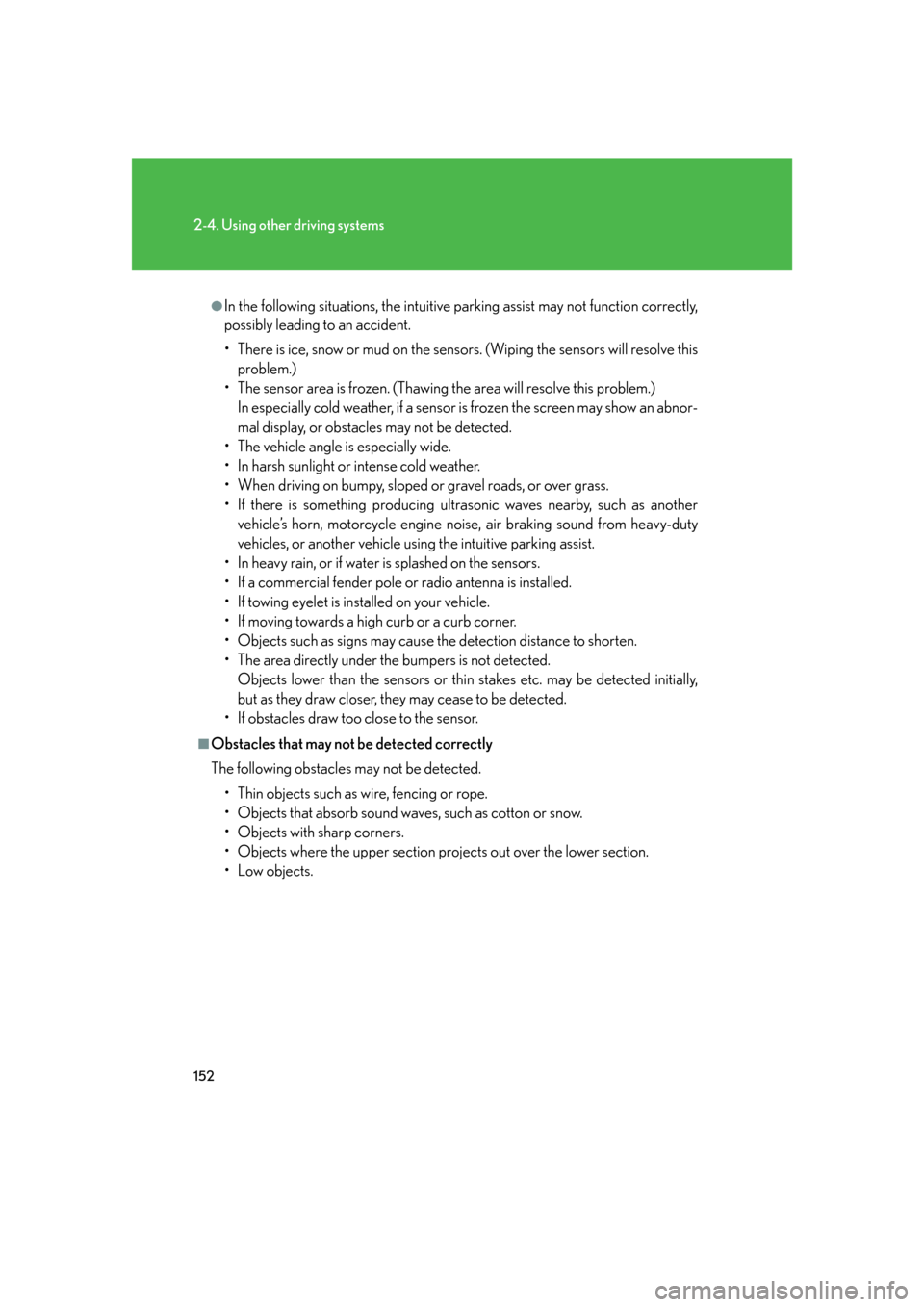
152
2-4. Using other driving systems
●In the following situations, the intuitive parking assist may not function correctly,
possibly leading to an accident.
• There is ice, snow or mud on the sensors. (Wiping the sensors will resolve this
problem.)
• The sensor area is frozen. (Thawing the area will resolve this problem.)
In especially cold weather, if a sensor is frozen the screen may show an abnor-
mal display, or obstacles may not be detected.
• The vehicle angle is especially wide.
• In harsh sunlight or intense cold weather.
• When driving on bumpy, sloped or gravel roads, or over grass.
• If there is something producing ultrasonic waves nearby, such as another vehicle’s horn, motorcycle engine nois e, air braking sound from heavy-duty
vehicles, or another vehicle using the intuitive parking assist.
• In heavy rain, or if water is splashed on the sensors.
• If a commercial fender pole or radio antenna is installed.
• If towing eyelet is installed on your vehicle.
• If moving towards a high curb or a curb corner.
• Objects such as signs may cause the detection distance to shorten.
• The area directly under the bumpers is not detected.
Objects lower than the sensor s or thin stakes etc. may be detected initially,
but as they draw closer, they may cease to be detected.
• If obstacles draw too close to the sensor.
■Obstacles that may not be detected correctly
The following obstacles may not be detected.
• Thin objects such as wire, fencing or rope.
• Objects that absorb sound waves, such as cotton or snow.
• Objects with sharp corners.
• Objects where the upper section projects out over the lower section.
•Low objects.